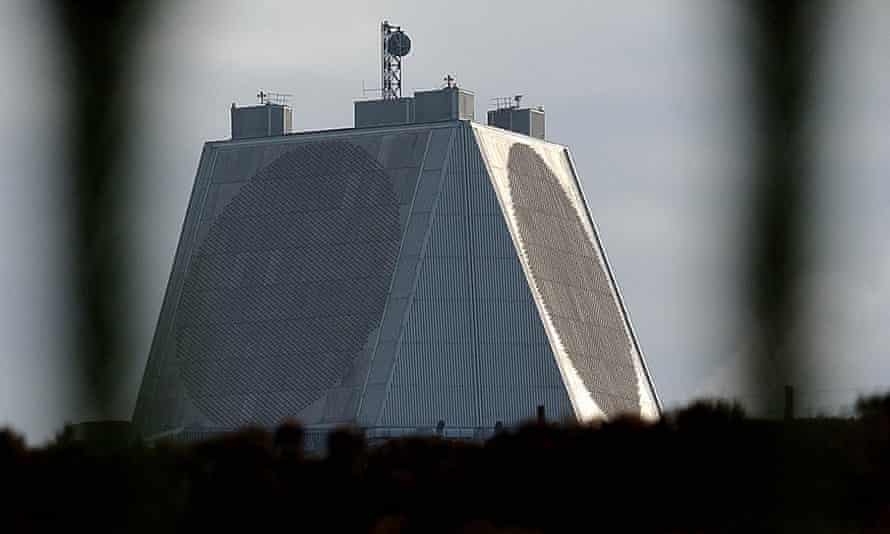SPACE WARS
RAF chief says system to track objects up to 22,000 miles from Earth is ‘incredibly important’

RAF Fylingdales can only detect objects up to 12,000 miles away while the Deep Space Advanced Radar Capability would look much further into space. Photograph: John Giles/PA
Mattha Busby
Sat 17 Jul 2021
An American space force plan to develop a global monitoring system to track objects up to 22,000 miles from Earth could establish radar stations in the US, UK and Australia.
The head of the RAF, Air Chief Marshal Sir Michael Wigston, is in the US for talks over the plans, and said on Saturday the British were “very interested” in the project and hosting one of the American radar stations.
China is challenging US military and technological dominance in a number of theatres, including in space. There are fears that anti-satellite arms held by Beijing – which Washington also possesses – are capable of threatening US orbital fleets.The Deep Space Advanced Radar Capability (Darc) would require three radar stations around the globe with possible sites in the UK, US and Australia, Wigston said, in order to get a “full picture” of what is happening.
“The first priority above all is to understand what is going on in space. We know that it is becoming more congested; there were 1,000 satellites launched in the last year alone,” he told BBC Radio 4’s Today programme. “We see activity by countries like China and Russia which is a cause for concern. It is reckless activity, deploying and testing of systems that look like weapons in space. So any system like the radar we are talking about which gives us a better picture of what is going on is incredibly important to us.”
However, the new American military branch, US Space Force, established by former president, Donald Trump, has been criticised as an unwise and costly escalation that could lead to a dangerous new arms race.
A spokesperson for the Campaign Against the Arms Trade said the plans were “totally misguided” and that the money would be better spent on reducing poverty.
“The huge sums of money involved would be far better spent building fairer and more equal societies here rather than further militarising space,” they said.
The stations, covering around a square kilometre, would host an array of large radar dishes, known as parabolic antenna, each 15 metres in diameter.
The US already operates an early warning system to detect ballistic missiles in space, which includes a facility at RAF Fylingdales in North Yorkshire. However, that can only detect objects up to 12,000 miles away while Darc would look much further into space.
Joe Mozer, chief scientist at the US Space Force, said: “We must overmatch our strategic competitors.”
Last month, Chinese scientists created a secure and potentially feasible chain of quantum communication along 428km of optical fibre, the longest terrestrial distance outside a lab, as part of efforts to create the world’s first unbreakable information link between orbiting crafts and their controllers.
Mattha Busby
Sat 17 Jul 2021
An American space force plan to develop a global monitoring system to track objects up to 22,000 miles from Earth could establish radar stations in the US, UK and Australia.
The head of the RAF, Air Chief Marshal Sir Michael Wigston, is in the US for talks over the plans, and said on Saturday the British were “very interested” in the project and hosting one of the American radar stations.
China is challenging US military and technological dominance in a number of theatres, including in space. There are fears that anti-satellite arms held by Beijing – which Washington also possesses – are capable of threatening US orbital fleets.The Deep Space Advanced Radar Capability (Darc) would require three radar stations around the globe with possible sites in the UK, US and Australia, Wigston said, in order to get a “full picture” of what is happening.
“The first priority above all is to understand what is going on in space. We know that it is becoming more congested; there were 1,000 satellites launched in the last year alone,” he told BBC Radio 4’s Today programme. “We see activity by countries like China and Russia which is a cause for concern. It is reckless activity, deploying and testing of systems that look like weapons in space. So any system like the radar we are talking about which gives us a better picture of what is going on is incredibly important to us.”
However, the new American military branch, US Space Force, established by former president, Donald Trump, has been criticised as an unwise and costly escalation that could lead to a dangerous new arms race.
A spokesperson for the Campaign Against the Arms Trade said the plans were “totally misguided” and that the money would be better spent on reducing poverty.
“The huge sums of money involved would be far better spent building fairer and more equal societies here rather than further militarising space,” they said.
The stations, covering around a square kilometre, would host an array of large radar dishes, known as parabolic antenna, each 15 metres in diameter.
The US already operates an early warning system to detect ballistic missiles in space, which includes a facility at RAF Fylingdales in North Yorkshire. However, that can only detect objects up to 12,000 miles away while Darc would look much further into space.
Joe Mozer, chief scientist at the US Space Force, said: “We must overmatch our strategic competitors.”
Last month, Chinese scientists created a secure and potentially feasible chain of quantum communication along 428km of optical fibre, the longest terrestrial distance outside a lab, as part of efforts to create the world’s first unbreakable information link between orbiting crafts and their controllers.
No comments:
Post a Comment